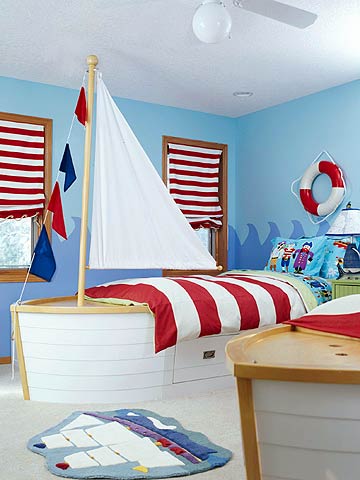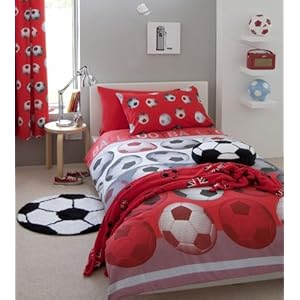
next boys bedroom decor
image

christina
Answer
I worked at a living history site for several years. This is what I can remember ...
Normally, if the land was at all good, the house would be two stories high. It was built of local materials, starting with a log cabin or, if the farm was quite prosperous, they would have built a stone or brick house to replace it.
Layout:
The ground floor generally had a parlour and kitchen with a broom closet under the stairs. The stairs were generally fairly steep because of lack of space. Compare this to something like the Doctor's house at Upper Canada Village where the stairs had lower risers and plenty of space for the feet -- conspicuous consumption! ;-)
Upstairs, depending on how big the downstairs was, there might be as many as three bedrooms.
Decor:
The parlour was only opened for special occasions, like a visit from the priest, a wedding, a funeral, Christmas. The walls in the parlour were usually plastered and painted. Heavy drapes covered the windows. The furniture seats seem low -- not because they were shorter than us (they weren't!) -- but because it's difficult to sit on a higher seat in a hooped skirt. The floor was painted if the family could afford it and, sometimes, they would paint a rug pattern onto the floor. If they didn't paint the pattern, they had scatter rugs -- usually braided or hooked from scraps. There might be a set of shelves that would hold the decorative items the family valued -- like china figurines, etc. There was usually a fireplace or, if they could afford it, a small stove. Rumford fireplaces (developed in the early 1800's) were known but not common by the 1840's. Often there would be a spinning wheel in the parlour, as this was the one place where couples could have some 'official' privacy (as opposed to the hay barn) in the house and the eldest daughter was supposed to keep spinning while her suitor was there. Her family was in the next room -- the kitchen.
The kitchen had another fireplace for cooking or baking, with a spit over it. Some brick fireplaces had bake ovens built into them, off to the side of the fireplace itself. (If they had a wood stove for cooking, it usually had a bake oven built into the back of it. Behind it was a metal sheet, hinged so that it stayed up of its own accord, that protected the wall from fire. It was also a useful place to dry tea towels.) The walls might be plastered smooth, or they might be the wooden logs with the cracks stuffed with mortar that made up the walls. Either way, they were painted, as was the floor. The ceiling beams, supporting the floor above, were usually exposed and painted. Table, chairs, sideboard, butter churn, wash tub, wash board; these were all things you would normally see in a kitchen of the period. Often there was a shelf that ran around wall, about six feet from the floor. We would call this a plate rail, but they used it for everything from a coffee grinder to a butter press to jars of preserves. There might be strings of dried fruit hanging from this, as well, depending on the time of year. By the back door, there would be a line of pegs for people to put coats, hats, shawls, and aprons on. On the floor at the door was usually another braided rug.
The doors were the lift latch kind for the most part -- on a farm. (Sorry, I don't know when doorknobs were invented or became fashionable.)
The windows were single glazed -- and had no screens.
Upstairs was normally divided into three bedrooms: parents, boys, and girls. Sometimes, the girls' room was reached by going through the parents' room. Wooden bed frames had two types of supports for the mattresses: the first was wooden slats (think Ikea). The second support was ropes, around the sides and back and forth (about six inches apart) from top to bottom. A second rope was then run top to bottom (and back), weaving over and under the ones that went from side to side and, again, about 6 inches apart. The mattress was usually canvas filled with straw or, if rich, down. Same with pillows. Pegs on the wall held the clothes and there was a bureau per room, usually with a mirror over it. (Bear in mind that the average farmwife had three dresses -- two to work in and one for Sunday or special occasions -- and that getting a new dress per year meant that the farm was doing well, so that other dresses could be handed down.) There was a washstand with a basin and pitcher of water. If there had been stoves on the ground floor, the pipes ran up through the bedrooms for a little extra heat. Otherwise there might be fireplaces, if they were doing *very* well. Oh, mustn't forget the chamber pots (also known as 'thunder mugs' because of the noise they make when used in the middle of the night) under the bed, too.
Colours:
They *loved* colours. Imagine living in a log house. Over a few years, it has turned grey from the weather. Now, imagine wintertime, you look around outside: white snow, grey fences, grey and brown tree trunks and branches, dark geen conifers (if there are some nearby). The brightest colour is the comb on the rooster, or maybe a light bay horse. The people wore dark colours because it didn't show the dirt as mush as light colours. So they decorated their houses with colours.
But ... if things weren't going well, it was a one story house -- kitchen and bedrooms. That's it.
Hope this is useful to you.
Boy's bedroom decor. ?

Paige
I have a 9 month old son, who will be 1 in October, and I'm also expecting another boy at the end of November...
We are moving into a new home next week, and since they will be close in age and sharing a room I was wondering if anyone had any ideas for decorating or useful advice when setting up their space.
Thanks. =]
Answer
Take my word for it....they won't care. Wait until they're older and see where their interests lie.
Powered by Yahoo! Answers




































